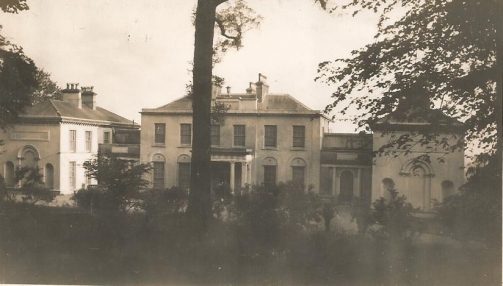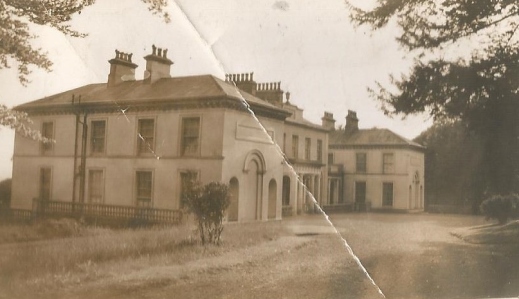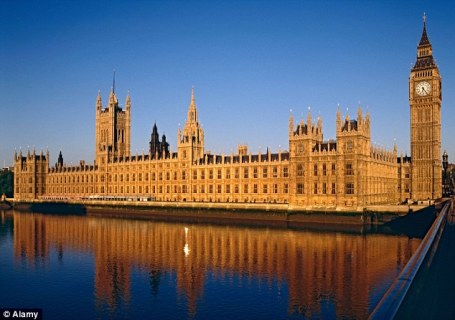
The entrance front of Ballyedmond House faced due north, allowing the drawing room and dining room to enjoy fine views to the south over Midleton. The staircase was located behind the two windows on the right of the porch. Note the chaste late Georgian style of the central block and the slightly more elaborate details of the two wings. The wings also housed additional accommodation for the family rather than the kitchen and stable.
Growing up in Midleton, I often heard of a grand country house that once stood on the brow of a hill not two miles north of the town. This was Ballyedmond House which, I was told, had a window for every day of the year. Sadly the house was demolished before I became seriously conscious of it. With three hundred and sixty five windows it must have been huge – and I longed to see a photograph of it. Curiously, Ballyedmond never belonged to the Brodricks, the landlords of Midleton until they sold all their remaining interests in 1966. In fact Ballyedmond’s last owner was a Smith-Barry.
Many years later I had the good fortune to meet somebody who had photos of this famous house (at least it was famous locally!). Some of these photos are reproduced here. Sadly, I don’t have an image of the house from the most public viewpoint – the road to Rathcormac which runs at the bottom of the valley below the site of the house. One thing is pretty clear from the photos – somebody in Midleton couldn’t count! There was simply no way that Ballyedmond House could boast 365 windows – it simply wasn’t big enough.
The Ballyedmond estate was in the civil parish of Templenacarriga, which is in the barony of Barrymore. It was inherited by the Courtenay family through a marriage with the Browne family. It seems that the Courtenays hired the Cork architect Abraham Hargrave the elder, and his son, also called Abraham, to either build the house or to restore it. The photographs show a house with a central block and two wings. However there is a problem – the central block is very clearly a restrained, even chaste, design of circa 1790 to 1820 with no trace of anything older in the structure. The online Dictionary of Irish Architects, run by the Irish Architectural Archive, suggests a date of 1809 to 1811 for the building,which suggests an entirely new house, perhaps on an old site.

The normal approach to Ballyedmond House was by a long winding driveway from the bottom of the hill eventually approaching the house from the east.
The entrance front of the central block faced due north. It was of six bays, with a two bay breakfront topped by a die rather than a pediment. The ground floor windows were set in shallow arches – a feature associated with the work of James Gandon. The entrance was by means of a Doric porch. Within this block, the staircase was located immediately to the right of the entrance hall and the two reception rooms were located on the garden front with splendid views south over the valley towards Midleton and beyond. The drawing room was decorated in the Louis Seize (Louis XVI) style which became quite fashionable in the early 19th century in Britain and Ireland as if to commemorate the executed King of France during the Napoleonic Wars.
The two links were given the appearance of triumphal arches on the entrance front. Complicating everything was the style of the two wings – they were more clearly more early Victorian in character, but with references to the late Georgian or Regency style. The wings presented a windowless front to the visitor. This facade was embellished with a shallow arch in the middle flanked by two niches. The sides of the wings had windows set in architraves – a detail missing from the central block. Also, the roof of each wing had a more elaborate bracketed cornice, whereas the central block had a much plainer cornice.
If the Hargraves simply restored an older house then they did such a thorough job that the evidence of the original house was almost totally subsumed in the restoration To all intents and purposes what the photos show sits perfectly within the 1809-1811 time frame – at least for the central block. It is essentially a new house. The two wings were almost of the same height as the central block and are joined to it by the somewhat more elaborate links. Curiously, the wings were not designed to perform the traditional functions of kitchen wing and stable wing respectively. (The stables and farmyard were located in a separate building further up the hill, and the was in the basement.) The wings were actually additional living quarters for the family and their guests, suggesting that that Ballyedmond was intended to accommodate plenty of house parties.
The house remained in the Courtenay family until 1861 when it passed by inheritance to a relative, Captain Richard Hugh Smith-Barry. He was the fourth son of John Smith- Barry, the builder of nearby Fota House who in 1814 married Eliza-Mary Courtenay, daughter of Robert Courtenay of Ballyedmond. The lack of male heirs on the Courtenay side later in the 19th century meant that Ballyedmond passed to the Smith-Barrys, who appropriately were directly descended from the Barrys, Earls of Barrymore.
The last resident owner was Guy Smith-Barry. He liked to take a telescope onto the roof to spy out any ships coming in to Cork Harbour at Roche’s Point (it was clearly visible from the house!). It is eighteen kilometers from Midleton to Roche’s Point by road, add some tour kilometers from Main Street in Midleton to Ballyedmond, it seems that Guy Smith-Barry was able to view ships some twenty two kilometers away! That’s about thirteen and a half miles, which gives you some idea of the view from the roof of Ballyedmond. If he was expecting guests Guy would dash down to his car and drive to Cork, arriving in time to greet his visitors as they disembarked from the ferry from England.
Sadly, in the 1960s, the cost of maintaining Ballyedmond House became prohibitive, and Guy Smith-Barry was obliged to sell off the house and demesne to a local businessman, who promptly demolished the great house. Not a trace of it remains today except for some of the demesne walls and gate lodges.
Note: Abraham Addison Hargrave (1755 – 1808) ,the elder, came from Horsforth, near Leeds in Yorkshire, and made an architectural career for himself in Cork City and County. He had four sons, three of whom became architects, while another became a civil engineer.






